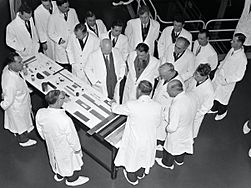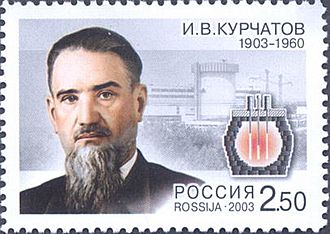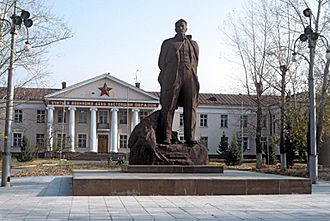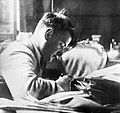Igor Kurchatov facts for kids
Quick facts for kids
Igor Kurchatov
|
|
|---|---|
| Игорь Васильевич Курчатов | |
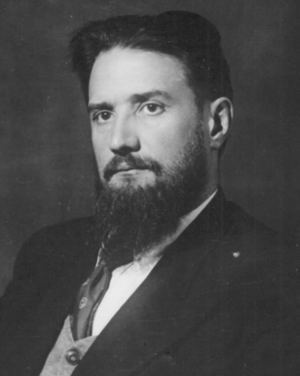 |
|
| Born |
Igor Vasilyevich Kurchatov
January 12, 1903 |
| Died | 7 February 1960 (aged 57) |
| Resting place | Kremlin Wall Necropolis |
| Nationality | Russian |
| Citizenship | |
| Alma mater | Leningrad Polytechnical Institute |
| Known for | Soviet atomic bomb project |
| Awards | |
| Scientific career | |
| Fields | Physics |
| Institutions | Arzamas-16 Ioffel Physico-Technical Institute Azerbaijan Polytechnic Institute |
Igor Vasilyevich Kurchatov (Russian: Игорь Васильевич Курчатов; born January 12, 1903 – died February 7, 1960) was an important Soviet physicist. He was a key leader in creating the Soviet Union's nuclear weapons program.
Kurchatov, who first studied to be a naval architect, taught himself a lot about nuclear physics. He was chosen by the Soviet government to quickly develop a "super bomb." With help from Soviet spies who gathered information on the American Manhattan Project, Kurchatov led the fast creation and testing of the first Soviet nuclear weapon. This bomb was similar to the first American one, called Fat Man. It was tested in 1949 at Semipalatinsk in Kazakhstan.
Kurchatov received many awards from the Soviet Union. He played a huge part in building Russia's modern nuclear industry. Sadly, his health quickly got worse, likely because of a radiation accident in 1949 at Chelyabinsk-40. This event was very serious. Kurchatov died in Moscow in 1960 when he was 57 years old.
Contents
Biography
Early Life and Education
Igor Kurchatov was born on January 12, 1903, in a small village called Simsky Zavod in Ufa, Russia. Today, this place is known as Sim in Chelyabinsk Oblast. His father, Vasily Alekseyevich Kurchatov, was a surveyor and a former assistant forester. His mother, Mariya Vasilyevna Ostroumova, was a school teacher. Igor was the second of three children. In 1912, his family moved to Simferopol in Crimea. The Kurchatov family was of Russian background.
After his older sister, Antonina, passed away, Igor grew up with his younger brother, Boris. They both went to Simferopol gymnasium №1. Igor also played the Mandolin in his school's orchestra. During World War I, Igor and Boris had to work to help their family. Igor became a skilled welder and became very interested in steam engines. He hoped to become an engineer.
University and Early Career
Kurchatov went to Crimea State University to study physics. He became known for his great skill in doing physics experiments. Because of this, he was given the title of "doctorate" for his practical abilities. Kurchatov then moved to Baku in Azerbaijan. There, he got a job helping with physics at the Azerbaijan Polytechnic Institute. He showed his experiments on electrical conduction there. Dr. Abram Ioffe, a famous physicist, was visiting and was very impressed. He invited Kurchatov to work at the Physico-Technical Institute in Saint Petersburg, Russia. In 1927, Kurchatov married Marina Sinelnikova. They did not have any children.
While working with Ioffe, Kurchatov studied things like ferroelectricity and semiconductors. He also went to Leningrad Polytechnic Institute to study engineering. He earned his engineer's degree in naval architecture in the 1930s. From 1931 to 1934, Kurchatov worked at the Radium Institute. In 1937, Kurchatov was part of the team that built Russia's first cyclotron. A cyclotron is a machine that speeds up tiny particles. This machine was installed at the Radium Institute. Research began there in 1939. Before 1933, Kurchatov mainly focused on electromagnetism. But in 1935, he did important work on nuclear isomers and radioactivity.
Wartime Contributions
In 1940, Kurchatov moved to Kazan. He questioned the idea of Spontaneous fission when Georgy Flyorov wrote a letter about its discovery. From 1942 to 1943, Kurchatov worked with the Soviet Navy in Murmansk. He and fellow physicist Anatoly Alexandrov found a way to demagnetize ships. This protected them from German mines during World War II. This method was used until the end of the war and even after. In 1944, Kurchatov wrote about the energy released from uranium. He said that breaking up one kilogram of uranium kernels would release energy equal to 20,000 tons of TNT.
Leading the Soviet Nuclear Program
Building the Bomb
After 1942, Igor Kurchatov became the main leader for the Soviet Union's nuclear program. This program included both military and peaceful uses of nuclear energy. Kurchatov is often called the "father" of the Soviet nuclear weapons program. He is sometimes compared to the American scientist Robert Oppenheimer, though Kurchatov was not a theoretical physicist (someone who uses math to understand physics).
The Soviet government did not start its nuclear program until 1943. This was despite getting information from Soviet spies in the United States and a warning from scientist Georgii Flerov. At first, Kurchatov, like many others, was working on making weapons for the Red Army to fight German forces in World War II. The Soviet government first asked Abram Ioffe to lead the nuclear program, but Ioffe suggested Kurchatov instead in 1942.
Kurchatov set up Laboratory No. 2 in Moscow. He brought in other talented scientists. For example, Abram Alikhanov worked on producing heavy water, and Lev Artsimovich was key in separating isotopes using electromagnetism. Kurchatov initially wanted to produce nuclear material without using foreign information. He aimed to use gas centrifuges, but this technology was not available to the Soviets until much later. Because of a tight deadline from Stalin, Kurchatov decided to use the Gaseous diffusion method, based on foreign data. This decision upset Pyotr Kapitsa, but his concerns were not listened to.
In its early years, the Soviet program faced many problems. But after the atomic bombings of Hiroshima and Nagasaki in Japan, it received full support. In 1942, Soviet intelligence told Kurchatov about the results from the Chicago Pile-1, the first nuclear reactor. Kurchatov then shared his ideas for making a nuclear bomb. In 1945, Kurchatov helped design and build the first reactor at Laboratory No. 2. This reactor successfully created a nuclear chain reaction in late 1946. Kurchatov, along with Alikhanov and Flerov, wrote a paper about making plutonium in a uranium graphite reactor. In 1947, Kurchatov worked with Isaak Kikoin to check the calculations from the information they got about the American program.
The First Soviet Bomb: RDS-1
In 1946, the Soviet program was pushed forward very strongly by Lavrenty Beria, a powerful Soviet official. Beria and Kurchatov had some disagreements, especially about Kurchatov's use of design information from Klaus Fuchs. Fuchs was a German physicist who worked on the American Manhattan Project and secretly shared information with the Soviets. Kurchatov used this data to meet Stalin's deadline. The design for the first Soviet nuclear device was started in the town of Sarov (now in Nizhny Novgorod Oblast), which was renamed Arzamas-16. Kurchatov brought in Dr. Yulii Khariton and Yakov Zel'dovich to the team. Kurchatov strongly defended their calculations, saying the data was very accurate.
The team also got help from information released by the US government and more details from Fuchs. However, Kurchatov and Beria worried that some of the intelligence might be false. So, they made sure their own scientists retested everything themselves. Beria used the intelligence as a way to double-check the scientists' findings.
Soviet spies in the United States were very helpful. They provided important information about American nuclear devices. This allowed Kurchatov to avoid long and costly trial-and-error problems. Kurchatov spent most of his time working on the "fissile material" (the material that splits to create a nuclear explosion). This material was made using gaseous diffusion and an "implosion-type plutonium core." German nuclear physicists also helped speed up the process of getting device data, working under Kurchatov's guidance.
Dr. Yulii Khariton oversaw the final assembly of the device. It was then moved to Semipalatinsk in Kazakhstan. On August 29, 1949, Kurchatov and his team successfully exploded their first test device, called RDS-1. This was a plutonium implosion bomb. Kurchatov later said his main feeling at that time was relief.
Beyond the Bomb: Nuclear Power
In 1950, work began on the thermonuclear weapon (hydrogen bomb). Scientists like Khariton, Sakharov, Zel'dovich, and Tamm worked on this under Kurchatov's leadership at Arzamas-16. Kurchatov helped with calculations, but much of the design work for the thermonuclear device, known as RDS-6, was done by Vitaly Ginzburg, Andrei Sakharov, Khariton, and Zel'dovich. This bomb was detonated in 1953.
By the time RDS-1 exploded, Kurchatov had decided to work on generating nuclear power for electricity. He worked closely with engineer Nikolay Dollezhal. This led to the creation of the Obninsk Nuclear Power Plant, near Moscow. This power plant opened in 1954 and was the world's first nuclear power plant. Kurchatov's knowledge of naval architecture also helped him design the first civilian nuclear ship, the Lenin.
After Stalin's death and the execution of Beria, Kurchatov began to speak about the dangers of nuclear war and nuclear weapon testing. He even visited England and spoke about the importance of Russian and Western scientists working together on nuclear fusion.
Death
In January 1949, Kurchatov was involved in a serious radiation accident at Chelyabinsk-40. To try and save the uranium and reduce losses in plutonium production, Kurchatov entered the damaged reactor hall, which was full of radioactive gases, without proper safety gear. After 1950, Kurchatov's health quickly got worse. He had a stroke in 1954. He died in Moscow from a heart embolism on February 7, 1960, at age 57. He was cremated, and his ashes were buried in the Kremlin Wall Necropolis on Red Square.
Legacy and Honors
During his time in the Soviet nuclear program, Kurchatov promised not to cut his beard until the program succeeded. He kept a large beard for the rest of his life, which earned him the nickname "The Beard." Kurchatov was a member of the Communist Party of the Soviet Union.
Many things are named after him:
- Two towns: Kurchatov Township in Kazakhstan and Kurchatov near Kursk in Russia (where a nuclear power station is).
- The Kurchatov Institute, a famous research center, which also has a large monument dedicated to him.
- The crater Kurchatov on the Moon.
- The asteroid 2352 Kurchatov.
Many of his students also became famous scientists, including Andrei Sakharov.
For his work in setting up the Soviet nuclear program, Kurchatov received many high honors. He was awarded the title of Hero of Socialist Labor three times. He received the Stalin Prize four times and the Lenin Prize once. He was also given a large sum of money, a special car, a private house, and free travel for life.
He was:
- A member of the Soviet Academy of Sciences (elected in 1943).
- Awarded five Orders of Lenin.
- Awarded two Orders of the Red Banner.
- Awarded medals like "For Victory over Germany" and "For the defense of Sevastopol."
Kurchatov was buried in the Kremlin Wall in Moscow. This is a special burial place for top Soviet officials. In 1960, his institute was renamed the I.V. Kurchatov Institute of Atomic Energy. Later, in 1991, it became the Russian Research Centre Kurchatov Institute. The Kurchatov Medal was created by the Academy of Sciences for excellent work in nuclear physics. In the past, the Soviet Union suggested naming element 104 "kurchatovium" (Ku) in his honor. Element 104 is now known as rutherfordium.
Images for kids
See also
 In Spanish: Ígor Kurchátov para niños
In Spanish: Ígor Kurchátov para niños


